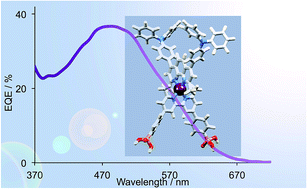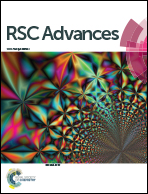Heteroleptic copper(i) sensitizers with one versus two hole-transporting units in functionalized 2,9-dimethyl-1,10-phenanthroline ancillary ligands†
Abstract
A series of homoleptic [Cu(L)2][PF6] complexes in which L is a 2,9-dimethyl-1,10-phenanthroline fused at the 5,6-positions with a 2′-functionalized imidazole (ligands 1–4), or substituted at the 4,7-positions with electron-donating 4-(diphenylamino)phenyl groups (ligand 5) is described; the imidazole 2′-functionality in 1 is 4-bromophenyl, in 2 is 4-(diphenylamino)phenyl, in 3 is 4-(bis(4-n-butoxy)phenylamino)phenyl, and in 4 is 4-(carbazol-9-yl)phenyl. The copper complexes were characterized by mass spectrometry, NMR and absorption spectroscopies and cyclic voltammetry; the single crystal structure of ligand 4 has been determined. Compared to the solution absorption spectra of [Cu(1)2][PF6], [Cu(2)2][PF6], [Cu(3)2][PF6] and [Cu(4)2][PF6], that of [Cu(5)2][PF6] shows increased absorbance at wavelengths >375 nm. An on-surface strategy was used to assemble heteroleptic [Cu(6)(L)]+ dyes on TiO2 electrodes where 6 is ((6,6′-dimethyl-[2,2′-bipyridine]-4,4′-diyl)bis(4,1-phenylene))bis(phosphonic acid); solid-state absorption spectra confirmed enhanced light-harvesting between 375 and 600 nm for [Cu(6)(5)]+ with respect to [Cu(6)(1)]+, [Cu(6)(2)]+, [Cu(6)(3)]+ and [Cu(6)(4)]+. Comparison of the performances of dye-sensitized solar cells (DSCs) containing [Cu(6)(2)]+, [Cu(6)(3)]+ and [Cu(6)(4)]+ with those with [Cu(6)(1)]+ indicate only a marginal influence of the diphenylamine or carbazole hole-transporting domains in 5,6-substituted phenanthroline dyes. The introduction of the 4-(diphenylamino)phenyl hole-transporting units in the 4- and 7-positions of the phen unit in 5 proves to be beneficial, with DSCs containing [Cu(6)(5)]+ performing better than those with the other four dyes; duplicate DSCs were tested for each dye to validate the results. While the values of the maximum external quantum efficiencies (EQEmax) for [Cu(6)(1)]+ and [Cu(6)(4)]+ are greater than for [Cu(6)(5)]+, the extension of the EQE spectrum for [Cu(6)(5)]+ to longer wavelengths results in higher short-circuit current densities (JSC) compared to DSCs with [Cu(6)(1)]+, [Cu(6)(2)]+, [Cu(6)(3)]+ and [Cu(6)(4)]+.


 Please wait while we load your content...
Please wait while we load your content...